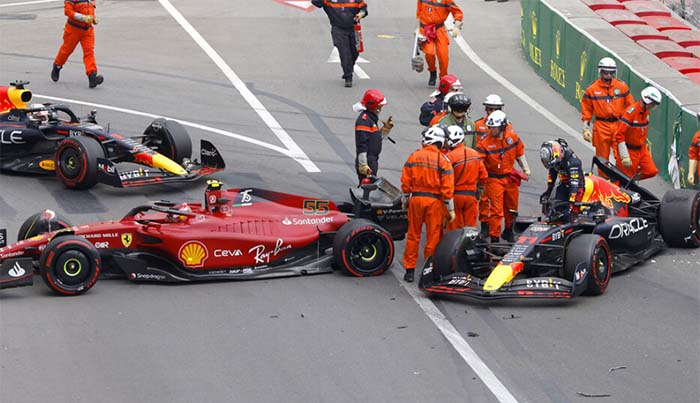The crash of Sergio Perez and later Carlos Sainz in Q3 in Monaco may reveal the floors of the two best cars on the current Formula One grid.

The crash of Sergio Perez and later of Carlos Sainz in Q3 in Monaco may reveal the floors of the two best cars on the current Formula 1 grid.
The ground effect cars produce a lot of downforce in the Venturi tunnels and in the invisible part of the floor that is only a few centimeters away from the asphalt. The downforce generated in the underbody still keeps the car relatively stable when a car is in the dirty air of the car in front.
The additional downforce is created by two conical tunnels that run backwards from the front end of the sidepods to the rear. The air is allowed to expand in the diffuser, which is pulled upwards, and this accelerates the flow under the car. This Venturi effect creates negative pressure in the channels, which sucks the vehicle onto the asphalt.
First of all, the goal is to get as much air as possible under the car to increase the ground effect. In addition, the aerodynamicists try to guide the flow through the channels in such a way that no air escapes to the sides, as this would reduce efficiency. At the floor entrance, three strongly curved fins divert some of the air to the outside in order to seal off the underbody at the sides. Artificial wake vortices are also created at the sharp edges of these fins, on which the flow is concentrated.
The side effect that engineers have to cope with is the "bouncing", which is now well known to all F1 fans, and which causes the car to bounce at high speed. According to Adrian Newey, the phenomenon occurs in the area of the underbody where most of the downforce is produced. Here the flow is not constant and is repeatedly interrupted under certain conditions, especially at high speeds
A small horizontal wing in the central skid area in front of the underbody can be used to influence the flow so that the downforce is more constant further back and the problem of the ticking is alleviated. Aston Martin and Ferrari were the first cars to show this trick. Red Bull and Mercedes have since followed suit. But the rigidity of the floor and the height in relation to the track also play an important role.
The post-accident footage of Perez and Sainz reveals some very interesting details. Firstly, it is noticeable that the Red Bull's underbody is designed much more elaborately. While the Ferrari's outer channels are split relatively evenly, the RB18's intakes are spaced at different distances. The outer channel is extremely narrow, which is only seen in the B version of the Aston Martin AMR-22.
As far as the channel profile is concerned, the Red Bull shows significantly more contours. The height and width vary more. There are even small edges and steps. In the case of the Ferrari, the tunnels extend to the rear in an elegant curve. At the rear, tapered, you can see only a small step in the F1-75, while in the Red Bull there are two prominent curves.
The opponents are certainly studying the pictures of the two best cars in F1 very closely. But simply copying them is not possible. Remodeling the underside of the floor is a complicated matter. Already at the front wing and wheel arch fins, the flow must be diverted so that it reaches the desired point at the floor entrance.
In times of budget limits, such a large conversion can hardly be managed. Copying the complete aerodynamic concept from another car is a task for next season. Red Bull and Ferrari will probably be able to enjoy their lead for a while longer, while Mercedes tries to get its different "zeropod" concept right from across the grid.